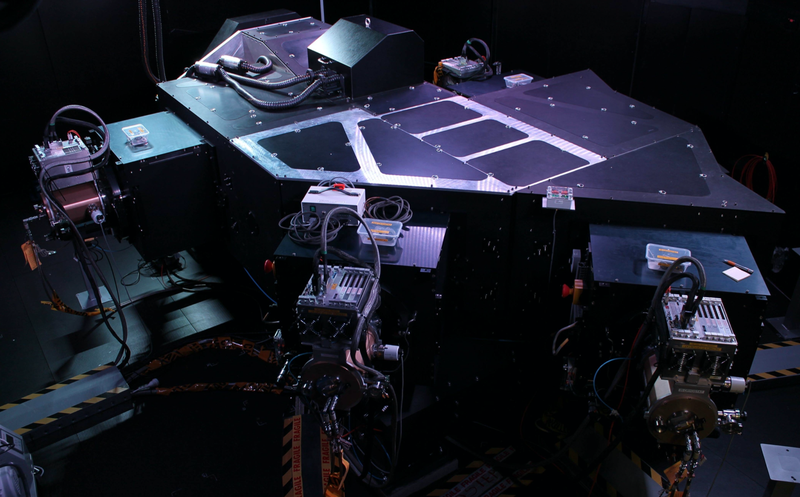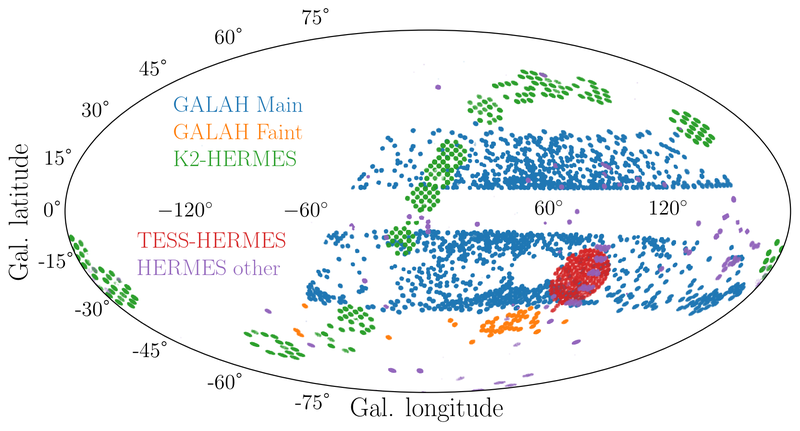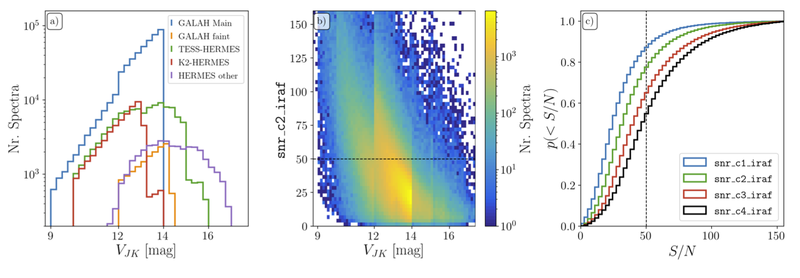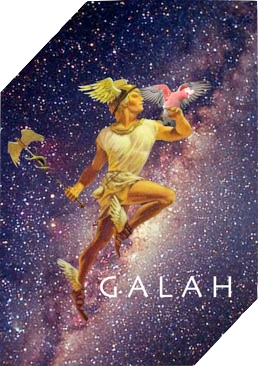Instrumentation, Target Selection and Observations
HERMES

GALAH observes using the HERMES spectrograph (Sheinis et al. 2015) at the Anglo-Australian Telescope. HERMES is a four-channel, multiobject, R~28,000 spectrograph fed by the 2dF fibre positioner (Lewis et al. 2002), which sits at prime focus. 2dF has two field plates, each of which has 392 science fibres and 8 guide bundles that can be allocated across a circular field with a two-degree diameter. One field plate can be set up by the fibre positioning robot while the other plate is being used for observation. Fibres subtend 2.1 arcseconds on the sky, with a positioning accuracy of 0.3 arcseconds, and have a minimum separation of about 30 arcseconds.
The fibres from the two 2dF plates are arranged in two pseudoslits that can move into place to inject light into the spectrograph. HERMES uses an off-axis collimator mirror, a series of dichroic elements, and volume phase holographic gratings to capture the wavelength regions 4715–4900 Å, 5649–5873 Å, 6478–6737 Å, and 7585–7887 Å in four cameras with independent shutters. The spectra are dispersed in the horizontal direction in the raw data, with one spectrum trace for each fibre.
HERMES spectra have a signal-to-noise ratio of 100 per resolution element in one hour of exposure time for stars with an apparent magnitude of 14 in the relevant Johnson/Cousins filter (B for the blue camera, V for the green camera, R for the red camera and I for the IR camera). The blue and green cameras use 16 micron, standard silicon detectors; the red camera has a 40 micron, deep depletion device with fringe suppression and an ER1 coating; and the IR camera has a 100-micron bulk silicon device with fringe suppression and a "Multi-9" coating. Further details on 2dF and HERMES can be found in the user manual.
2018 Field Flattening Lens Replacement
In the first half of 2018, the original field flattening lenses of HERMES were replaced (Edgar et al 2018). The original glass contained uranium that emitted α particles, which caused the saturated points and vertical readout streaks when they were captured by the HERMES CCDs. The point spread function in the HERMES cameras changed as a result of changing the field flattening lenses, and is now larger and less symmetric in the corners of the detectors. As part of HERMES recommissioning, the GALAH team fed light from a Fabry-Perot interferometer into HERMES to characterise the new PSF across each detector, and this information has been incorporated into the data reduction procedure.
Target Selection

The initial GALAH input catalog was made by combining the 2MASS (Skrutskie et al. 2006) catalog of infrared photometry with the UCAC4 (Zacharias et al. 2013) proper motion catalogue. We only included stars with reliable 2MASS data, as captured in their data quality flags (Q="A", B="1", C="0", X="0", A="0", prox 6"). We also rejected any star that had a nearby bright neighbour, with a rejection radius dependent on the bright star’s V magnitude, such that the potential target is rejected if the bright star is closer than (130 − [10 × V]) arcseconds.
The four main projects included in the GALAH DR3 catalogue are GALAH-main, GALAH-faint, K2-HERMES, and TESS- HERMES. The survey_name column of the main catalogue informs by which survey a given star was observed.
| Survey | survey_name | Selection function |
|---|---|---|
| Main GALAH survey | galah_main | Potential targets are all stars with 12 < V < 14, δ < +10° and |b| > 10° in regions of the sky that have at least 400 targets in π² degrees (the 2dF field of view) |
| GALAH-faint survey | galah_faint | Aimed at extending survey observations to regions with low target density. Given the lower density of stars the target selection was shifted to 12 < V < 14.3 as a way to maintain at least 400 stars per field |
| K2-HERMES | k2_hermes | Both "bright" (10 < V < 13) and "faint" (13 < V < 15, J − KS > 0.5) target cohorts, to complement the asteroseismic targets that are the focus of the K2 Galactic Archaeology Program (Stello et al. 2017) |
| TESS-HERMES | tess_hermes | Stars in the range 10.0 < V < 13.1 in the TESS Southern Continuous Viewing Zone (Sharma et al, 2018; doi.org/10.1093/mnras/stx2582) |
| Other programs | other | Targeted observations in open clusters, the GALAH Pilot Survey (Martell et al. 2017), or targets from other HERMES observing that were not part of any of these surveys. |
The list of fields is available in file galahfco_3_public.txt (download link). Each field is specified by its location (ra, dec) and has a unique identifier field_id. Each row describes a field configuration. There can be multiple rows with same field_id indicating different configurations that the field can be observed in, e.g., fields observed with different magnitude ranges specified by (vmin ,vmax). Description of the available columns is given below.
- field_id: (int) Unique field identifier
- ra: (deg)
- dec: (deg)
- radius: (deg) Ranging from 0 to 1.0
- selfunc: (int) Selection function
- vmin: Minimum V(J,K) magnitude
- vmax: Maximum V(J,K) magnitude
- vsplit: V(J,K) mag used for complicated selection functions
- vexp: V(J,K) magnitude used to set exposure time.
- progname: (str) one of the following ['bright', 'galah', 'galah_faint', 'galah_ufaint', 'k2', 'ocluster', 'repeat0', 'tess']
- fco_id: field configiration identifier, row number in the table
- priority: (int) 0 or 1 (for internal use)
- active: (int) 0 or 1 (for internal use)
- special: (int) 0 or 1 (for internal use)
Observations
GALAH data are acquired with the 3.9-metre Anglo-Australian Telescope at Siding Spring Observatory. Up to 392 stars can be observed simultaneously using the 2dF robotic fibre positioner (Lewis et al. 2002) that sits at the telescope’s prime focus. The fibres run to the High Efficiency and Resolution Multi-Element Spectrograph (HERMES De Silva et al. 2015; Sheinis et al. 2015), where the light is dispersed at R ∼ 28 000 and captured in four independent cam- eras. HERMES records ∼ 1000 Å of the optical spectrum across its four non-contiguous channels.
Targets for the main GALAH survey are selected to fall in one of three magnitude ranges: 9<V<12 (bright fields), 12<V<14 (regular fields), or 12<V<14.3 (faint fields). For observability from Siding Spring Observatory, declination is restricted to −80°<δ<+10°, and to avoid target confusion and excessive extinction, Galactic latitude is restricted to |b|>10. These targets are tiled into 6545 fields on the sky, with a field radius that varies with target density and a minimum density of 400 stars per field. Fields containing more than 400 stars are subdivided into multiple 400-star configurations. Observers use software developed within the team to choose configurations to observe, ensuring that the field centre will be within 2 hours of the meridian through the whole observation.
The coordinates and proper motions for the targets in each configuration are input into the Configure program, along with a set of 20 candidate fiducial stars for guiding. The fiducial stars are taken from the GALAH target catalogue in the same field of view, with magnitudes in the range 11 < V < 12. Configure finds an optimal arrangement for the science targets and fiducial stars using a simulated annealing algorithm and outputs a file that is passed to the fibre positioning robot to set up the field. Further details on Configure can be found in Miszalski et al. 2006.
The standard observing procedure for regular GALAH survey fields is to take three 1200s exposures, which is extended to four science exposures if the seeing is between 2 and 2.5 arcseconds, and to six exposures if the seeing is between 2.5 and 3 arcseconds. Flat-field and arc exposures are taken directly before or after each science configuration, since moving between the two pseudoslits moves the position of the spectrum traces on the detector slightly. Bright-star fields are observed in evening and morning twilight, and in case of seeing too poor for the regular survey fields. They receive three 360s exposures and the same calibration frames.

Above is the distributions of magnitudes and S/N of GALAH DR3. Panel a) Distribution of V magnitude calculated from 2MASS J and KS . Panel b) Distribution of average achieved S/N per pixel for the green band (CCD 2) as a function of VJ K . Panel c) Cumulative distribution of the S/N per pixel of the different bands/CCDs of HERMES for GALAH DR3. A black, dashed line indicates the overall S/N of 50 that we initially aimed for for CCD2.
